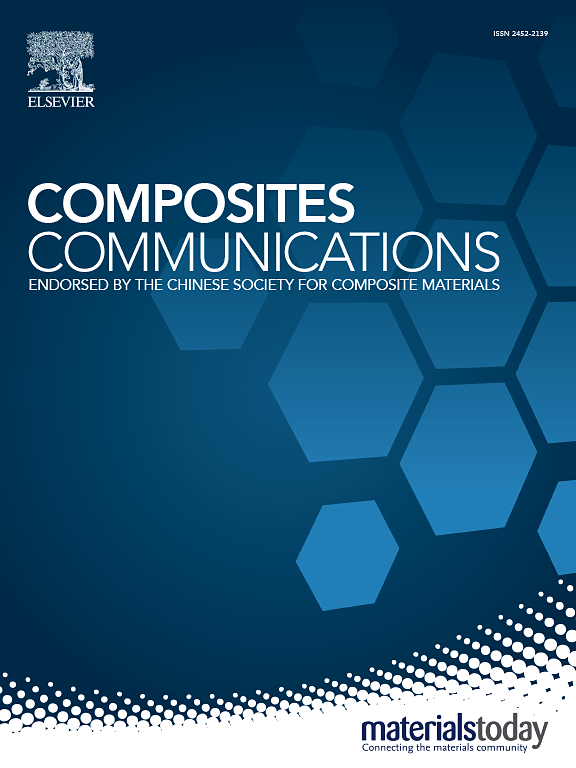Phase-field simulation study on the mechanical behavior and fracture mechanism of SiC-p/Al composites considering microstructural effects under uniaxial tension
IF 7.7
2区 材料科学
Q1 MATERIALS SCIENCE, COMPOSITES
引用次数: 0
Abstract
A microstructure-based fracture phase-field model was employed to reveal deformation and failure mechanisms in SiC particle-reinforced aluminum (SiC-p/Al) composites under tension. By integrating real microstructure reconstruction with elastoplastic fracture phase-field theory, the model captures stress distribution, crack initiation, and propagation dynamics across varying SiC volume fractions (10 %, 15 %, 20 %). Key findings demonstrate that lower SiC content induces localized stress concentrations near particle polar regions, while higher fractions form interconnected high-stress networks (>800 MPa) due to reduced interparticle spacing and stress bridging effects. Equivalent plastic strain transitions from localized shear bands to diffuse distributions as particle interactions intensify, though cluster-induced strain hotspots (>0.03) persist at 20 % SiC. The simulations reveal three distinct failure modes: (1) low-volume composites exhibit tortuous crack paths with delayed coalescence, driven by matrix plasticity; (2) intermediate fractions show accelerated crack linkage along interparticle channels; (3) high-volume clusters trigger brittle-dominated failure mechanisms involving interfacial debonding and particle cleavage. A peak strength-ductility synergy occurs at 10 % SiC, while 20 % SiC shows severe embrittlement with rapid crack network percolation. Simulations capture adaptive "circum-particle/matrix-penetrating" crack alternation and cluster-induced secondary cracking leading to macroscopic fracture bands. This multiscale approach bridges microstructural realism with fracture predictability, emphasizing interfacial strength and dispersion uniformity as critical damage tolerance factors for designing high-performance composites.
考虑微观组织效应的SiC-p/Al复合材料单轴拉伸力学行为及断裂机制的相场模拟研究
采用基于显微组织的断裂相场模型揭示了SiC颗粒增强铝(SiC-p/Al)复合材料在拉伸作用下的变形破坏机制。通过将真实微观结构重建与弹塑性断裂相场理论相结合,该模型捕获了不同SiC体积分数(10%、15%、20%)下的应力分布、裂纹起裂和扩展动态。关键发现表明,较低的SiC含量会导致颗粒极区附近的局部应力集中,而较高的SiC含量由于颗粒间距减小和应力桥接效应而形成相互连接的高应力网络(>800 MPa)。随着颗粒相互作用的加剧,等效塑性应变从局部剪切带转变为弥漫性分布,尽管团簇诱发的应变热点(>0.03)在20% SiC时仍然存在。模拟结果显示了三种不同的破坏模式:(1)在基体塑性的驱动下,小体积复合材料呈现出弯曲的裂纹路径和延迟的合并;(2)中间段裂纹沿粒间通道加速联动;(3)大体积团簇触发脆性主导的破坏机制,包括界面脱粘和颗粒解理。SiC含量为10%时出现峰值强度-延性协同效应,而SiC含量为20%时出现严重脆化,裂纹网络渗透迅速。模拟捕获了自适应的“环颗粒/基体穿透”裂纹交替和团簇诱导的二次裂纹,导致宏观断裂带。这种多尺度方法将微观结构的真实性与断裂的可预测性联系起来,强调界面强度和分散均匀性是设计高性能复合材料的关键损伤容限因素。
本文章由计算机程序翻译,如有差异,请以英文原文为准。
求助全文
约1分钟内获得全文
求助全文
来源期刊

Composites Communications
Materials Science-Ceramics and Composites
CiteScore
12.10
自引率
10.00%
发文量
340
审稿时长
36 days
期刊介绍:
Composites Communications (Compos. Commun.) is a peer-reviewed journal publishing short communications and letters on the latest advances in composites science and technology. With a rapid review and publication process, its goal is to disseminate new knowledge promptly within the composites community. The journal welcomes manuscripts presenting creative concepts and new findings in design, state-of-the-art approaches in processing, synthesis, characterization, and mechanics modeling. In addition to traditional fiber-/particulate-reinforced engineering composites, it encourages submissions on composites with exceptional physical, mechanical, and fracture properties, as well as those with unique functions and significant application potential. This includes biomimetic and bio-inspired composites for biomedical applications, functional nano-composites for thermal management and energy applications, and composites designed for extreme service environments.
 求助内容:
求助内容: 应助结果提醒方式:
应助结果提醒方式:


